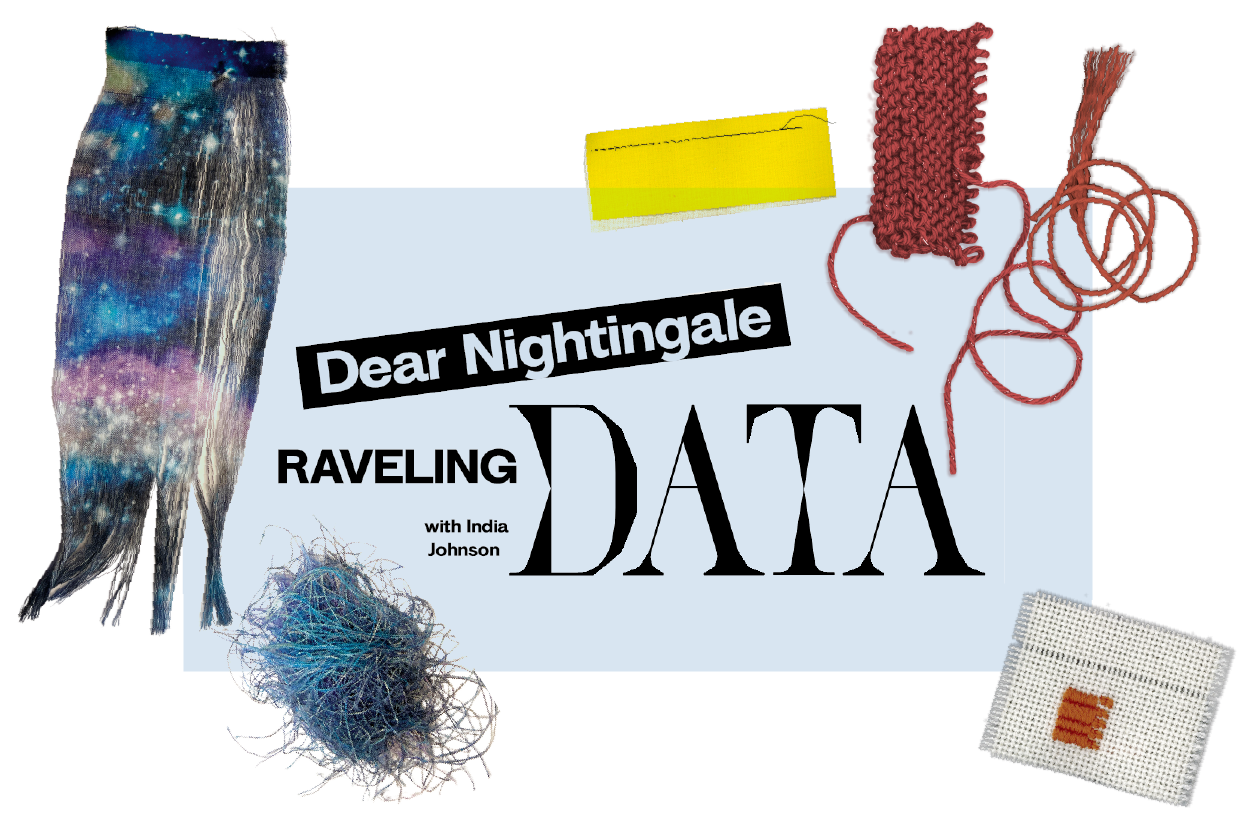This article originally appeared in Issue 3 of Nightingale magazine. (Get your copy here!) This challenge is brought to you by textile artist India Johnson.
When we think about data viz and textiles, the Tempestry Project—“personal and collaborative fiber art, environmental education, and climate activism through data representation”—often comes to mind. Representing climate data in an ancient textile medium reflects its gravity; the deliberate work of knitting or crocheting data mirrors how deliberate we must be in grasping this global problem and mitigating it.
Just as textiles like a Tempestry are laborious to create, they are laborious to pick apart. Whether we are makers motivated by thrift and sustainability, crafters honing our technique, or artists driven by conceptual concerns, working with fibers often involves raveling finished cloth. A quilter salvages material from the clothing of someone who has passed for a memory quilt. A knitter ravels a sweater that no longer fits to reclaim the yarn. An artist unpicks her grandmother’s embroidered linens to ponder the baggage of inherited possessions. In ancient Greek myth, Penelope buys much-needed time as she weaves by day and unweaves by night.
Other times, raveling is an intermediary step in creation. Some embroidery projects use waste canvas as a stitching guide, which must later be painstakingly removed. An especially precise way to cut a garment on grain is to select a single thread to unpick at the point you wish to cut.
For this challenge, take time to ravel your data. Unpick a seam, fray a scrap of woven or knitted fabric, or remove stitches to illustrate data that is meaningful to you. You may wish to visualize data that points to absence or loss, for instance. Raveling can take time, so you may decide to focus on a single statistic or data point, rather than a dataset. Consider documenting the textile before and after your intervention.
Practical tips
- Many professional seamstresses use razor blades in addition to seam rippers; they can be a speedy (but sharp) way to undo stitching.
- Sewing pins are useful for selecting and unpicking a single thread.
- Knitted textiles, like a sweater, will ravel much more easily than woven textiles, like a dress shirt.
- There’s no need to buy fabric—reduce waste and reach first for scrap fabric or clothing beyond repair.
- Need to count threads easily? Try an evenweave fabric such as Aida cloth or a scrap of coarsely-woven fabric like burlap.
- Yard goods (like yarn and ribbon) are easily measured to a specific length; keep in mind that yarn can be separated into multiple plies.
- Pick a spot with good window light for your project, or use a bright LED work lamp. Take breaks as needed—this work might strain eyes and hands.
Need inspiration?
Here are some textile deconstruction projects that I find particularly interesting:
- The WPA Milwaukee Handicraft Project unraveled military-surplus burlap bags to weave into textiles.
- “Unraveling” (2015, by Sonya Clark) deconstructs the Confederate battle flag thread by thread.
- “Unraveling” (2006-18, by Jean Shin) illustrates the network of relationships in the Asian American art community.
Let’s see your raveled data! Send in one high-resolution image plus a 50-word description by AUGUST 4, 2023 (deadline extended!).










